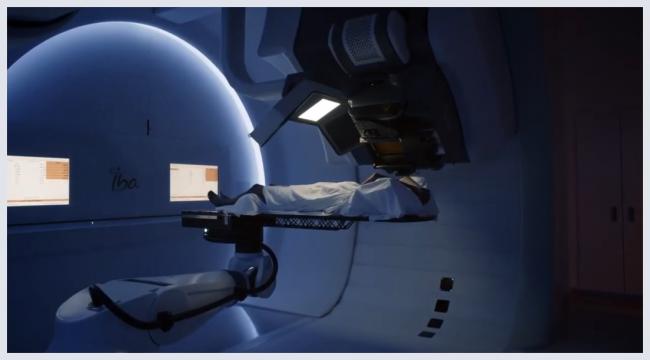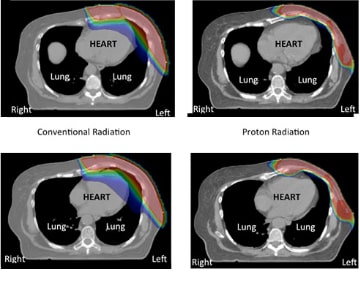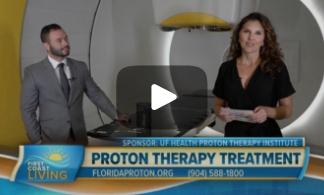Breast cancer patients may benefit from proton therapy radiation, which can decrease radiation to the heart and lungs.
For many patients with breast cancer, radiation can be a valuable part of treatment. Proton therapy is a type of radiation that stops at a very specific point in the targeted tissue; conventional radiation continues beyond the tumor. This unique feature of proton therapy can be used to decrease the radiation dose to the nearby tissues. In breast cancer, this means on average no radiation to the heart and on average 50% less radiation to the lung as compared with conventional radiation.1
When we decrease the amount of radiation to the heart and lungs, we lower the risk of developing side effects such as heart disease, reduced lung function, or secondary cancer. The proton therapy advantage may be more likely in cases where cancer has developed in the left breast, since it is situated so close to the heart. Whether cancer develops in the right breast or left breast, clinical research pilot study results have shown the proton therapy plan to be superior to the conventional plan in reducing the amount of radiation to the heart and lungs.1 Additionally, proton therapy may provide better dose coverage to the lymph node regions as compared with conventional radiation.
UF Health Proton Therapy Institute physicians work closely with each patient’s surgeon and medical oncologist to create a comprehensive treatment plan. Typically, proton therapy begins four to six weeks following surgery or chemotherapy, and is given over a period lasting six weeks.
University of Florida Health Proton Therapy Institute currently treats:
- Stage I, II, and III breast cancer
- Locally advanced breast cancer
- Node positive breast cancer
Eligible patients include those who are:
- ER, PR positive or negative
- Her2Neu positive or negative
- Triple positive
- Triple negative
- With/without implants or expanders
UF Health Breast Center — Jacksonville
We provide multidisciplinary care as a part of the comprehensive breast cancer treatment team. Breast cancer screening, diagnostic care, education and a full range of treatments including surgery, chemotherapy and radiation therapy, are coordinated and customized for women and men with breast cancer.
The breast center is accredited by the National Accreditation Program for Breast Centers, administered by the American College of Surgeons.

Find out if you are a candidate for proton therapy today.
Didn’t find your answer?
Common options for breast cancer treatment:
After mastectomy, treatment may include:
Radiation to the chest wall +/- regional lymph nodes
Chemotherapy
Antiendocrine therapy (hormone therapy)
OR
After lumpectomy, treatment may include:
Radiation to the breast +/- regional lymph nodes
Chemotherapy
Antiendocrine therapy (hormone therapy)
After mastectomy, treatment may include:
Radiation to the chest wall +/- regional lymph nodes
OR
After lumpectomy, treatment may include:
Radiation to the breast +/- regional lymph nodes
Antiendocrine therapy (hormone therapy)
The science of treating breast cancer with proton therapy
Breast cancer is often treated with multiple modalities, including surgery, radiation therapy, and systemic therapy (e.g., chemotherapy, biologic therapy, antiendocrine therapy). Breast-conserving therapy, which consists of lumpectomy followed by radiation therapy, is equally effective against breast cancer as mastectomy (removal of the entire breast) for many patients. For advanced breast cancer or breast cancer that has spread to the lymph nodes, radiation is often recommended even after mastectomy. In addition, for large tumors or tumors that have spread to the lymph nodes, the radiation field is extended to include the breast or chest wall and the lymph nodes regions in the axilla (underarm region), supraclavicular region (along the collar bone), and internal mammary chain (along the sternum). Radiation therapy decreases the chance of the cancer coming back in the breast or chest wall and lymph node regions and, in many cases, also improves overall survival.
Particularly in cancers that develop in the left breast, there is a risk of part of the heart receiving radiation, due to the proximity of the heart to the breast tissue. Part of the lung also receives radiation when the breast or chest wall is treated. When the radiation field includes the lymph node regions, the dose the heart and lung receive is a little higher than when just the breast or chest wall is treated.
Proton therapy is a type of radiation that can be stopped at a prescribed depth in tissue, whereas conventional radiation continues beyond the tumor. This unique feature of proton therapy can be used to decrease the radiation dose to the nearby tissues. In breast cancer, this means less radiation dose to the heart and lung.

We have completed our first clinical trial at UF Health Proton Therapy Institute evaluating proton therapy for treatment of node positive and high-risk node negative breast cancer patients. The results of this study were published in May 2016 and contributes to the growing body of literature on proton therapy for breast cancer (see references). Our next studies will focus on measuring heart function after proton therapy in efforts to quantify the benefit compared to conventional radiation.
1 Bradley JA, Dagan R, Ho MW, Rutenberg M, Morris CG, Li Z, Mendenhall NP. Initial Report of a Prospective Dosimetric and Clinical Feasibility Trial Demonstrates the Potential of Protons to Increase the Therapeutic Ratio in Breast Cancer Compared With Photons. Int J Radiat Oncol Biol Phys. 2016 May; Vol. 95(1):411-21
2 Xu N, et al. Can proton therapy improve the therapeutic ratio in breast cancer patients at risk for nodal disease? Am J Clin Oncol. 2013 Mar 4.
3 MacDonald SM, et al. Proton therapy for breast cancer after mastectomy: early outcomes of a prospective clinical trial. Int J Radiat Oncol Biol Phys. 2013 Jul 1.
4 MacDonald SM, et al. Proton radiotherapy for chest wall and regional lymphatic radiation; dose comparisons and treatment delivery. Radiat Oncol. 2013 Mar 24.





